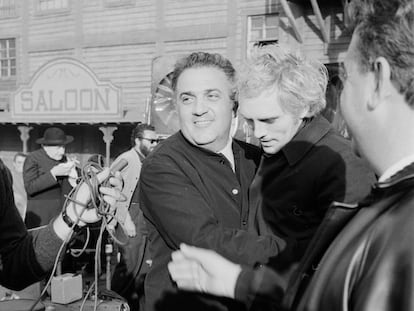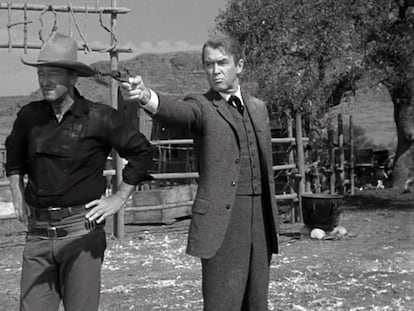Pedro Almodóvar will shoot his first English-language feature film in New York City
The legendary Spanish filmmaker has just screened his medium-length movie ‘Strange Way of Life’ at the Cannes Film Festival. The Western flick stars two gay cowboys, played by Ethan Hawke and Pedro Pascal, and makes an effort to subvert the genre: ‘I just hope the Americans don’t find it too daring’

The presence of legendary Spanish director Pedro Almodóvar at the Cannes Film Festival always causes a stir. This time, he’s participating in a special screening of his medium-length film, Strange Way of Life. It stars Ethan Hawke and Pedro Pascal as two ex-lovers, who cross paths again out of passion and with new intentions. Almodóvar, 73, in addition to presenting the film at the French festival, will host a public conversation with Hawke, which caused tickets to be sold out within seconds online.
On the eve of the trip, Almodóvar spoke to EL PAÍS about his creative process, his small-town upbringing, as well as his aversion to the Western genre, which eventually turned into a passion. He even tried to shoot a Western in the mid-1990s. The filmmaker also discussed what he learned from A Manual for Cleaning Women — produced by and starring Cate Blanchet —, a project he had to abandon. And finally, he announced that after two medium-length films, he plans to shoot his first English-language feature in the coming months.
One summer, five years ago, Almodóvar turned on his computer and wrote a story. He saved it, along with many others. “It’s my typical writing process. Often, I do it just for pleasure. Something occurs to me, I write 10 to 15 pages and file them on the computer,” he explains. “One afternoon, I wrote the dialogue of two cowboys the morning after their reunion, after spending a whole night fucking and drinking. I liked it a lot and decided to keep it.”
Some of the stories — stored on his computer and in old blue folders — have been grouped together in the book The Last Dream, which the filmmaker published a month ago. But the story about the cowboys stood out. “I wrote it in part, but not only, as a response to Brokeback Mountain.” Ang Lee’s film was one of the offers from Hollywood that Almodóvar rejected, because he understood that the studio was not going to let him “develop the action” how he wanted to.
“[In the film] there’s a nod to Brokeback Mountain, when [the cowboys] are considering what two men are going to do on a ranch. Pedro Pascal responds to Heath Ledger [in an imaginary crossing of characters]. That movie was the only time that Hollywood, in a big production, spoke about that particular world and the mutual desire of two men, although it was a modern Western and, instead of cowboys, the characters were actually shepherds.”
For Almodóvar, the fact that there are no more Westerns with gay characters “speaks [to the fact] that there is some taboo, because it’s a totally masculine genre.” He also recalls the few movies from that genre that have female leads, such as Johnny Guitar. “Of course, it’s a film by Nicholas Ray, who was always a special director, who subverted genres,” he clarifies. “It’s like in bullfights or men’s soccer: we don’t talk about homosexuality, because the taboo goes over in a similar way. In the Western, we’ve never talked about the desire between two cowboys. I was very interested in that dramatic development.”
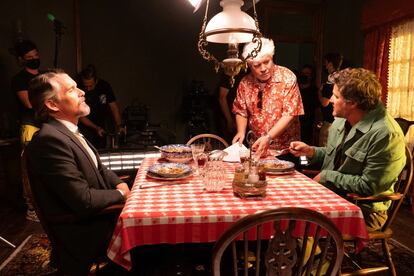
The filmmaker always saw this medium-length movie coming to life as a piece of micro-theater, until a year after writing it, he ran into Anthony Vaccarello, the creative director for Yves Saint Laurent. The designer proposed a production. “Vaccarello had just produced Lux Aeterna — by Gaspar Noé — and I immediately thought of those two cowboys, in developing how they get into their situation, and how they get out of it.”
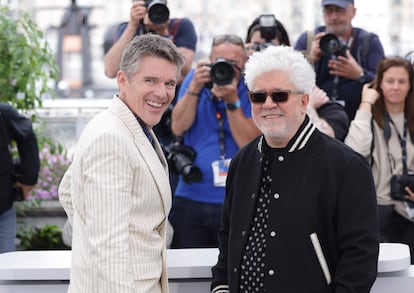
To what extent did Almodóvar film this 31-minute long movie while thinking that he would later have to make A Manual for Cleaning Women, a project that he ultimately abandoned? “In fact, the two shorts — which, by the way, have whetted my appetite to continue shooting in this format — were born out of that, of meaning wanting to experiment with directing movies in English,” he explains. “Before and during the filming of Strange Way of Life, I had a lot of time to reflect on A Manual for Cleaning Women, and this led me to realize that it was too big a project for me,” he says.
“Above all, due to my physical condition. [For the pre-production], I had to make many long trips to Ciudad Juárez, Albuquerque, Oakland, a Mexican bay near Acapulco... And my back couldn’t take it. And another reason, which I realized during my free time, when I was waiting for Cate Blanchett [producer and star of the film, who is continuing with the project] was that I’m very picky with the decoration department. I supervise every detail — each element of the set, every chair and table and book, was going to be made from scratch — and just thinking about it… Phew. Since it’s a period piece, everything had to be manufactured. I realized that I was going to go crazy, that I wasn’t going to have enough control [over the project],” he adds.
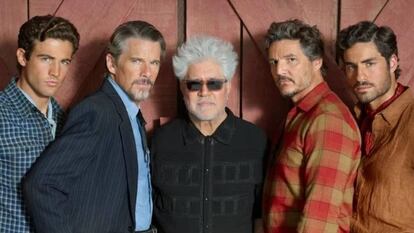
And what does he think about the fact that — after decades of being his boss — his former leading lady was also going to be his producer and superior? “We didn’t talk about it, really, because Cate didn’t have much time. If I had shot [the film] last year, I would have gotten into the movie and I would have made the best of it. But that 12-month-long waiting period allowed me to write another story that I liked, film this short, face my doubts.”
“There was another issue. I rehearse a lot: I quickly realized that neither Pedro nor Ethan are used to my rhythm. And there are only two main characters in the movie! In A Manual for Cleaning Women, there are many more characters, sets and locations. I sensed it was going to be impossible. With great pain in my heart — because I really liked the script — I understood that the most honest thing to do was to get off the project. I guess I’ve been terrible to Cate,” he says.
Almodóvar shot Strange Way of Life last summer in Almería, in the southern Spain. “I can’t stop seeing it as a short film. I like that it’s being screened in Cannes; it seems like an unbeatable place, [because they give so much] love to cinema,” he explains. As in much of his filmography, there’s a struggle between passion and family, between which of the two ties is stronger. “Traditional values, the family, are part of the heart of the Western. And this enriches the story of the two characters. I thought of them as two of William Holden’s wild bunch, who hook up one night, break up, and meet again 25 years later: one is now a sheriff, the other is a father, coming to defend his son. The desire remains, although both men have opposite interests.” Almodóvar phoned Hawke and Pascal directly, and they accepted instantly. “They’re perfect for the characters.”
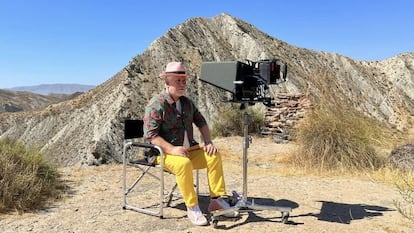
In the background of Strange Way of Life, Almodóvar’s subversive nature is detectable. One example is the pictorial reference to Georgia O’Keefe — one of her paintings appears on the wall of the ranch in the final sequence. The director explains this symbolism: “I’m fascinated by O’Keefe’s varied work… Those mountains, those flowers, those things. The only thing that is anachronistic [about the film] is fado (a genre of music with origins in Portugal). I indulged myself, because it’s necessary to quickly introduce the viewer into the melancholy of the story. In the rest of the film, I’ve been very careful: I used paintings by Maynard Dixon — the first painter to focus on cowboys and Indians for his work in magazines, with very comic book-esque colors — and a painting by Lillie Langtry, who was a star at the time of my film, [which is set in the 1920s or 1930s].”
“Look, I didn’t want to be caught in an anachronism, when I’ve always been the same.” As further evidence of this, Pascal wears a green jacket in the film, which Almodóvar quickly justifies with an image of James Stewart in Winchester 73, directed by Anthony Mann. The jacket is identical.
The Western film: an American genre
Regarding the genre, Almodóvar recalls that, as a boy, he never played the children’s game Cowboys and Indians. “The Western never interested me much, until I moved to Madrid [from Calzada de Calatrava]. Today, I have many DVDs [of American classics by] Anthony Mann, or John Sturges. I don’t have many European ones, except by [the Italian] Sergio Corbucci.”
In the mid-1990s, Almodóvar even considered shooting a Western. He bought the rights to Tom Spanbauer’s novel, The Man Who Fell in Love with the Moon (1991). “I did it in a Tennessee Williams-esque tone, although it was infinitely more erotic, with Indians and gay cowboys. I wrote the script, but no one dared produce such a gay and erotic Western,” he says.
The filmmaker points out another detail about the Western, the great American genre: “[The U.S. has used it] to build their national epic; they’ve stylized and embellished their past.” And that’s why he’s been inspired by the movies, but not by the reality of the times portrayed.
“I hope that the Americans don’t find it too daring,” he shrugs. “Because the Western is the most conservative genre. It speaks to many values, such as land, honor when there is no law, the use and possession of weapons. This cinema served as a means of bolstering support for the Second Amendment of the American Constitution.”
Almodóvar’s professional future has already been decided. “I’m preparing my new film, but at a moderate pace. We’ve planned to shoot three weeks of exterior shots in New York in October and the interiors in Spain, when there are very few usable daylight hours. I already have the locations set, although my problem is that the two leading actresses are very busy. Neither of them are available before August; if it were up to me, we’d already be filming.”
He won’t say who the actresses are, or what the plot is about; only that the movie will be shot in English. “With Cate Blanchett, I’ve discovered that I have to be humble in my work. What I’m good at is the contemporary style; I can do all the art direction, making intimate films with few characters. I’m best when I work directly with the actors, as if it were a play.”

Sign up for our weekly newsletter to get more English-language news coverage from EL PAÍS USA Edition
Tu suscripción se está usando en otro dispositivo
¿Quieres añadir otro usuario a tu suscripción?
Si continúas leyendo en este dispositivo, no se podrá leer en el otro.
FlechaTu suscripción se está usando en otro dispositivo y solo puedes acceder a EL PAÍS desde un dispositivo a la vez.
Si quieres compartir tu cuenta, cambia tu suscripción a la modalidad Premium, así podrás añadir otro usuario. Cada uno accederá con su propia cuenta de email, lo que os permitirá personalizar vuestra experiencia en EL PAÍS.
¿Tienes una suscripción de empresa? Accede aquí para contratar más cuentas.
En el caso de no saber quién está usando tu cuenta, te recomendamos cambiar tu contraseña aquí.
Si decides continuar compartiendo tu cuenta, este mensaje se mostrará en tu dispositivo y en el de la otra persona que está usando tu cuenta de forma indefinida, afectando a tu experiencia de lectura. Puedes consultar aquí los términos y condiciones de la suscripción digital.
More information
Archived In
Últimas noticias
Most viewed
- Sinaloa Cartel war is taking its toll on Los Chapitos
- Oona Chaplin: ‘I told James Cameron that I was living in a treehouse and starting a permaculture project with a friend’
- Reinhard Genzel, Nobel laureate in physics: ‘One-minute videos will never give you the truth’
- Why the price of coffee has skyrocketed: from Brazilian plantations to specialty coffee houses
- Silver prices are going crazy: This is what’s fueling the rally
